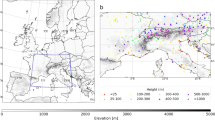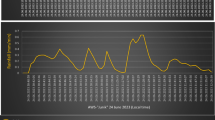Abstract
The present study describes an analysis of Asian summer monsoon forecasts with an operational general circulation model (GCM) of the European Centre for Medium Range Weather Forecasts (ECMWF), U.K. An attempt is made to examine the influence of improved treatment of physical processes on the reduction of systematic errors. As some of the major changes in the parameterization of physical processes, such as modification to the infrared radiation scheme, deep cumulus convection scheme, introduction of the shallow convection scheme etc., were introduced during 1985–88, a thorough systematic error analysis of the ECMWF monsoon forecasts is carried out for a period prior to the incorporation of such changes i.e. summer monsoon season (June–August) of 1984, and for the corresponding period after relevant changes were implemented (summer monsoon season of 1988).
Monsoon forecasts of the ECMWF demonstrate an increasing trend of forecast skill after the implementation of the major changes in parameterizations of radiation, convection and land-surface processes. Further, the upper level flow is found to be more predictable than that of the lower level and wind forecasts display a better skill than temperature. Apart from this, a notable increase in the magnitudes of persistence error statistics indicates that the monsoon circulation in the analysed fields became more intense with the introduction of changes in the operational forecasting system.
Although, considerable reduction in systematic errors of the Asian summer monsoon forecasts is observed (up to day-5) with the introduction of major changes in the treatment of physical processes, the nature of errors remain unchanged (by day-10). The forecast errors of temperature and moisture in the middle troposphere are also reduced due to the changes in treatment of longwave radiation. Moreover, the introduction of shallow convection helped it further by enhancing the vertical transports of heat and moisture from the lower troposphere. Though, the hydrological cycle in the operational forecasts appears to have enhanced with the major modifications and improvements to the physical parameterization schemes, certain regional peculiarities have developed in the simulated rainfall distribution over the monsoon region. Hence, this study suggests further attempts to improve the formulations of physical processes for further reduction of systematic forecast errors.
Similar content being viewed by others
References
Blondin C and Böttger H 1987 The surface and sub-surface parameterization scheme in the ECMWF forecasting system;ECM WF Research Department Tech. Memo. No. 135, 48pp
Chapman S and Lintzen R S 1970Atmospheric tides, thermal and gravitational, (Dordrecht, Holland: D. Reidel) 209 pp
Heckley W A 1985a Systematic errors of the ECMWF operational forecasting model in tropical regions,Q J R. Meteorol. Soc. 111 709–738
Heckley W A 1985b The performance and systematic errors of the ECMWF tropical forecasts(1982–84);ECMWF Technical Report No. 53
Illari L 1989 The quality of satellite PWC data and their impact on analyzed moisture fields;Tellus A41 319–337
Jaeger L 1976 Monatskarten des Niederschlags fur die Ganze Erde;Berichte des Deutschen Wetterdienstes 139 18
Kanamitsu M (1985) A study of the predictability of the ECMWF operational forecast model in the tropics;ECM WF Technical Report No. 49
Miller M and Palmer T 1987 Orographic gravity wave drag: Its parameterization and influence in general circulation and NWP models;Proc. of the ECMWF Seminar on Observation, Theory and Modelling of Orographic Effects, 15–19 Sept. 1986, Vol.I, 283–333
Mohanty U C, Pearce R P and Tiedtke M 1984 Numerical experimentation on the simulation of the 1979 Asian summer monsoon;Tech. Rep. No. 44, ECMWF, Reading, U.K.
Mohanty U C, Heckley W A and Ramesh K J 1995 A study of the systematic errors of the tropical forecasts: Influence of physical processes;Meteorology and Atmospheric Physics (in press)
Oberhuber J M 1988 An atlas based on the COADS data set: The budget of heat, buoyancy and TKE at the surface of the global ocean;Max-Planck Inst. for Meteorology Report No. 15, Max-Planck Institute fur Meteorologie, Hamburg 13, Germany
Ritter B 1985 The impact of alternative treatment of infra-red radiation on the performance of the ECMWF model,Proc, of the IAMAP International Radiation Symp. 1984, Perugia, Italy, 277–280 [DEEPAK: USA]
Reed R J, Hollingsworth A, Heckley W A and Delsol F 1986 An evaluation of the performance of the ECMWF operational forecasting system in analyzing and forecasting tropical easterly wave disturbances Part I: Synoptic Investigation;ECMWF Technical Report No. 58
Reed R J, Klinker E and Hollingsworth A 1987 An evolution of the performance of the ECMWF operational forecasting system in analyzing and forecasting tropical easterly wave disturbances Part II: Spectral Investigation;ECMWF Technical Report No. 60
Simmons A J, Burridge D M, Jarraud M, Girard C and Wergan W 1989: The ECMWF medium range prediction models, Development of the numerical formulations and the impact of increased resolution,Met. and Atm. Physics,40, 28–60
Slingo J M, Mohanty U C, Tiedtke M and Pearce R P 1988 Prediction of the 1979 summer monsoon onset with modified parameterization schemes;Mon. Weather Rev. 116 328–346
Slingo J M and Ritter B 1985 Cloud prediction in the ECMWF model;ECMWF Technical Report No. 46.
Tiedtke M, Geleyn J F, Hollingsworth A and Louis J F 1979 ECMWF model parameterization of sub-grid scale processes;Tech. Rep. No. 10, ECMWF, Reading, U.K.
Tiedtke M, Heckley W A and Slingo J 1988 Tropical forecasting at ECMWF: The influence of physical parameterization on the mean structure of forecasts and analyses;Q. J. R. Meteorol. Soc. 114 639–664
Wergen W, 1987 Diabatic nonlinear normal mode initialization for a spectral model with a hybrid vertical coordinate;ECMWF Tech. Rep. No. 59
Wiscombe W J and Evans J W 1977 Exponential sum fitting of radiative transmission function;J. Compusl. Phys. 24 416–444
Author information
Authors and Affiliations
Rights and permissions
About this article
Cite this article
Mohanty, U.C., Ramesh, K.J. Systematic errors in the medium range prediction of the Asian summer monsoon circulation. Proc. Indian Acad. Sci. (Earth Planet Sci.) 104, 49–77 (1995). https://doi.org/10.1007/BF02842275
Received:
Revised:
Issue Date:
DOI: https://doi.org/10.1007/BF02842275




